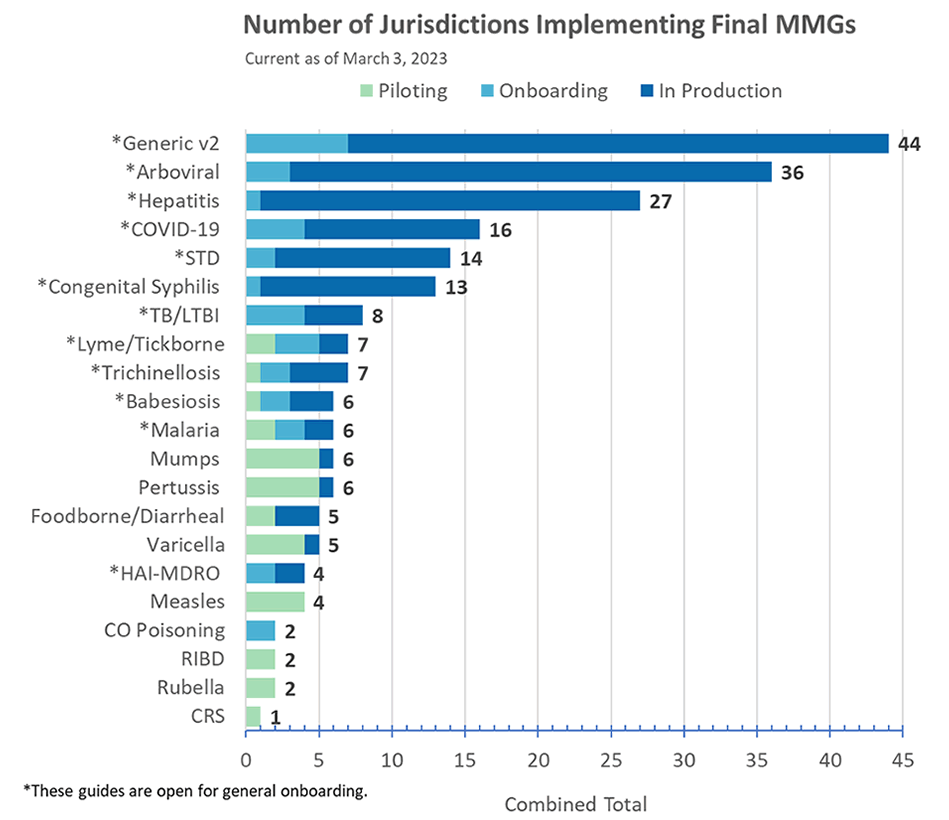March 2023
April 18, 2023, 3:00–4:00 PM ET: April eSHARE Webinar: “The NIOSH Industry and Occupation Computerized Coding System (NIOCCS) Tool: Automated Coding of Occupational Health Data.”
June 25–29, 2023: 2023 Council of State and Territorial Epidemiologists (CSTE) Annual Conference in Salt Lake City, UT. Register for the conference.
Bringing public health together to standardize case surveillance data elements

On February 21, 2023, CDC and the CSTE Data Standardization Work Group hosted an eSHARE training webinar titled “Case Surveillance Data Standardization—Paving the Way for Increased Interoperability.”
The webinar, which was attended by over 300 informatics and surveillance professionals representing state, local, and territorial health departments and CDC programs, introduced attendees to CDC’s and CSTE’s collaboration to make case surveillance more efficient by standardizing data across the case surveillance ecosystem for greater interoperability and automation.
Creating the future of case surveillance

Data standardization is a high-priority component of the effort to modernize case surveillance. However, it will require an investment of effort and close collaboration across public health to work through the many complex technical and structural barriers to implementation.
CDC and the CSTE Data Standardization Work Group’s efforts to bring together jurisdictions, CDC programs, and other case surveillance experts to discuss these challenges and to provide recommendations is an essential step on this journey.
“This is not a state we will get to by flipping a switch,” Sara Johnston, NNDSS Program Lead, explained during the webinar. “It is a process that will take time. However, the future is ours to create.”
Join the CSTE Data Standardization Workgroup
CSTE holds meetings of the Data Standardization Workgroup the last Friday of each month at 1:00 PM ET. Contact Becky Lampkins using the link above to learn more.
Expanding core data
A key objective is to expand core data, or data elements that are available for any condition in a jurisdiction’s surveillance system. By identifying common categories of information collected during public health reporting and investigation and agreeing on data standards, this approach can provide a shared foundation for disease-specific information and help streamline case surveillance. This includes:
- asking for the core data the same way across all conditions.
- allowing jurisdictions to include these new “expanded core” data elements in their system as general data elements for any condition.
- making it easier to set up new conditions because the format for collecting and sending expanded core data elements is already there.
Speaking the same language

For systems to talk to each other and share automated services, they must speak the same language. Public health must collaborate to align data throughout the case surveillance ecosystem. Drawing on the standards used by health care, increasing consistency across jurisdictions as well as across diseases, and reducing variation in what CDC requests will make more data available more quickly and more easily.
“Efforts to standardize and promote interoperability across electronic health record systems provided a common language and made more data available. Public health needs to apply the same principles to public health data exchange,” Johnston noted.
Promoting collaborative discussion
To inform planning for future efforts and encourage participants to share their thoughts, the webinar posed several discussion questions. Discussion questions included:
- What should the structure of expanded core case data look like?
- Where should these data come from?
- How are date elements represented in existing standards such as electronic case reporting and electronic laboratory reporting?
- Are related data elements already defined in U.S. Core Data for Interoperability (USCDI) and USCDI+?
- What standardization work has already been completed or is ongoing?
- How are data elements represented across case notification message mapping guides?
- How should data elements be prioritized?
Learn more:
Access the slides and recording in the NNDSS eSHARE archives for February 21, 2023.
Contact Becky Lampkins at blampkins@cste.org to join the CSTE Data Standardization Work Group or if you have questions or feedback for CSTE.
Contact Danielle Tack at dot7@cdc.gov if you have questions or feedback for CDC.
Updates on 2022 NNDSS Annual Reconciliation
CDC expects to kick-off the process of reconciling 2022 annual NNDSS data in mid-May 2023. CDC uses the annual reconciliation process to confirm that information in the CDC NNDSS database matches information in jurisdictions’ databases before finalizing data for the year.
What to expect

CDC is planning key changes to the 2022 annual reconciliation process as part of ongoing efforts to modernize public health data. CDC expects these changes to increase transparency, reduce email communication, and improve control for jurisdictions as they work through the reconciliation process. This includes:
- adding the ability to complete reconciliation tasks within the Message Validation, Processing, and Provisioning System (MVPS) portal;
- offering more flexibility to conduct reconciliation tasks throughout the year while automating tasks that previously required burdensome email communication; and
- expanding functionality, augmenting secure data exchange features, and organizing process flows.
In addition to providing more guidance and training on the updated reconciliation process in the coming months, CDC is developing a user guide to help jurisdictions learn about these new features and capabilities.
Preparing for 2022 annual reconciliation
Jurisdictions should ensure that staff involved in reconciliation, including State and Territorial Epidemiologists and Sexually Transmitted Disease (STD) Data Managers, have access to the Message Validation, Processing, and Provisioning System (MVPS) portal. Jurisdiction Data Managers can request access for their jurisdiction staff by emailing the CDC Electronic Data Exchange mailbox at edx@cdc.gov with subject: “New MVPS User Access.”
CDC also encourages jurisdictions to begin clean-up of your 2022 data, including reviewing and comparing cases using functionality available in the MVPS portal, such as line lists, case summaries, and errors and warnings.
Jurisdictions can do these activities now:
- ensure the 2022 data in your surveillance system are complete and correct;
- send case notification updates to correct the data;
- use the MVPS portal to review your 2022 data for low-incidence conditions that require verification; and
- inform your NNDSS Surveillance Officer if you have reporting exception changes for 2022.
Join the April and May 2023 eSHARE webinars, where CDC is planning to provide additional information about the 2022 annual reconciliation process.
Contact your jurisdiction’s NNDSS Surveillance Officer listed in the “Did You Know” box below if you have questions or feedback for CDC about 2022 annual reconciliation.
Have questions about 2022 annual reconciliation? NNDSS Surveillance Officers are here to help!
- Alan Schley (aso7@cdc.gov): AZ, DC, DE, KY, MT, NJ, NY, OH, OK, SD, UT, WI, U.S. territories
- Courtney Cook (uns6@cdc.gov): CO, FL, HI, IA, MD, MN, ND, NM, NV, RI, SC, WA, WV
- Diana Onweh (onw1@cdc.gov): AR, CT, GA, ID, IL, IN, LA, MI, MS, NH, PA, TN, TX, WY
- Keaton Hughes (qwy4@cdc.gov): AK, AL, CA, KS, MA, ME, MO, NC, NE, NYC, OR, PR, VA, VT
CDC has cancelled the March 2022 eSHARE webinar. The next eSHARE webinar, titled “The NIOCCS Tool: Automated Coding of Occupational Health Data,” will be held April 18, 2023, 3:00–4:00 PM ET.
To join an eSHARE webinar, please see your calendar invitation or contact edx@cdc.gov for login information with the subject line “eSHARE invitation.”
While CDC has paused most disease-specific mapping guide (MMG) development and onboarding efforts as part of modernizing case surveillance, we encourage jurisdictions to implement and onboard the generic version 2 (GenV2) and the tuberculosis/latent tuberculosis infection (TB/LTBI) MMGs.
Congratulations to Nebraska for being in production for the COVID-19 MMG!
Case Surveillance Modernization Update
To enhance case surveillance and reduce burden on state, local, and territorial jurisdictions participating in the National Notifiable Diseases Surveillance System (NNDSS), CDC is collaborating with jurisdictions and public health partners to modernize case surveillance.
Key implementation updates for March 2023:
- CDC Data Modernization Initiative priority team 2 finished a project to help identify core case data elements for national situational awareness. CDC is using information from the project to inform our work with CSTE Data Standardization Workgroup.
- CDC continues to use Epidemiology and Laboratory Capacity (ELC) Cooperative Agreement Health Information Systems team calls with jurisdictions to verify status of MMG implementation. This information helps CDC customize guidance for jurisdictions that choose to implement an MMG that aligns with current guidance.
CDC is sharing recurring, operational progress updates through channels such as Case Surveillance News and monthly eSHARE training webinars. CDC will also share time-sensitive information about actions for jurisdictions, key milestones, and project decisions using the NNDSS email list via edx@cdc.gov.
Jurisdiction support is critical to the success of this effort. CDC is continuing to work with jurisdictions to better understand their needs and status of MMG onboarding work. CDC encourages jurisdictions to give feedback on any barriers or obstacles faced with implementing the recommendations.
Visit CDC’s Frequently Asked Questions webpage to find answers to common questions from state, local, and territorial jurisdictions. Although we’re still working on the answers to many of your questions, CDC will continue updating this page as we have more information to share.
You can also use this jurisdiction feedback form to provide input and ask questions. We look forward to hearing from you!




